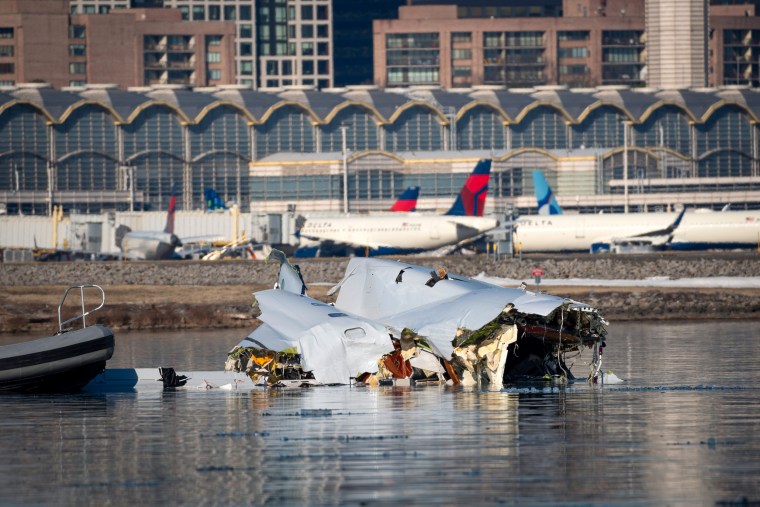
American Airlines Flight 5432’s fuselage and engine were lifted out of the Potomac River on Monday, starting the difficult task of clearing the remaining debris after a military helicopter struck it and crashed last Wednesday.
In order to recover all 67 people who perished in the airborne accident in the Washington, D.C., region, officials believe what’s left of the jet must be removed from the crash site. According to officials, the effort started at daylight on Monday.
At a press conference on Sunday, D.C. Fire and EMS Chief John Donnelly stated, “We’re going to recover everyone.” The bodies of 55 victims have so far been positively identified.
“If we knew where they were, though, we would already have them out, so we have some work to do as the salvage operation goes on, and we will absolutely stay here and search until such point as we have everybody,” he stated. Near-zero vision in the murky waters has presented challenges for recovery crews.
D.C. Fire and EMS Assistant Chief Gary Steen stated at a news briefing Monday evening that further remains discovered during recovery efforts Monday are being identified by the D.C. Office of the Chief Medical Examiner. According to Steen, he thinks the wreckage contains the remaining human remains in the Potomac.
Over the course of three days, the Baltimore District of the U.S. Army Corps of Engineers intends to gradually remove the jet’s remnants from the river. Sean Duffy, the U.S. Secretary of Transportation, stated that he would be there on Monday to witness the wreckage disposal.
According to the army’s announcement, the operation will make use of two surface-supplied diving systems, a crane barge, deck barges, and dive boats.
During Monday’s briefing, U.S. Army Corps of Engineers Baltimore district Colonel Frank Pera stated that the American Airlines engine was taken out of the Potomac and loaded onto a barge at approximately 10 a.m. The plane’s fuselage was raised out of the sea about midday.
Pera stated that he believes teams will accomplish the aim before the end of the day, adding that the attempt to remove one of the plane’s wings started around 2:30 p.m. Lifting the cockpit out of the water is the aim for Tuesday.
Although weather conditions may affect Tuesday’s operations, Pera said he thinks personnel are on schedule to meet their wreckage salvaging targets.
“That goal may be impacted tomorrow by a couple of environmental conditions, notably the wind,” Pera stated. “But we’re going to stay conscious kind of where those gusts and sustained winds are, and we’ll make sure that we’re communicating that effectively.”
The National Transportation Safety Board will move the debris to a hangar so they can continue their investigation into what caused the incident.
The remains of the Black Hawk chopper will thereafter be the focus of the recovery crews. The operation’s “large lifts” phase should be completed by Saturday, while other debris removal should continue until at least February 12. When a body is found, this work will be automatically stopped.
Baltimore District Commander Col. Francis Pera praised the extraordinary amount of coordination that took place both on the Potomac and behind the scenes. Our top priorities remain the safety of our crews and finding the missing so that their families and loved ones can get closure. We have not and will not lose sight of these goals.
However, the availability of lifts, weather, and tides all affect the recovery timeframe.
Using synced data from flight and voice recorders, air traffic controller communications, and radar scope, transportation safety board investigators recovered crew training and flight logs from both aircraft and are creating a timeline for the incident, the board announced Monday.
The NTSB said in a statement that it anticipated having a preliminary report within 30 days of the occurrence, which would include the crash’s likely cause.
